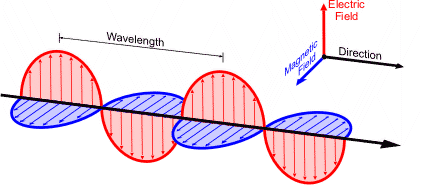
Draw the diagram of an electromagnetic wave.
Answer
471k+ views
2 likes
Hint: Electromagnetic waves are also known as EM waves that are produced when an electric field comes in contact with the magnetic field. It can also be said that electromagnetic waves are the composition of oscillating electric and magnetic fields. Time varying magnetic fields give rise to electric fields and vice-versa. The behavior of time dependent electromagnetic waves is described by a set of equations known as Maxwell’s equations.
Complete step by step solution:
We have seen that in certain situations light
Where,
The constant
There is also the sinusoidally varying magnetic field associated with the electric field when light propagates. This magnetic field is perpendicular to direction of propagation as well as to the electric field
Such a combination of mutually perpendicular electric and magnetic fields is referred to as an electromagnetic wave in vacuum.

Electromagnetic waves are shown by a sinusoidal graph. It consists of time-varying electric and magnetic fields which are perpendicular to each other and are also perpendicular to the direction of propagation of waves. Electromagnetic waves are transverse in nature. The highest point of the wave is known as crest while the lowest point is known as a trough. In vacuum, the waves travel at a constant velocity of
Note: Following are a few applications of electromagnetic waves:
1. Electromagnetic waves can transmit energy in vacuum or using no medium at all.
2. Electromagnetic waves play an important role in communication technology.
3. Electromagnetic waves are used in RADARS.
4. UV rays are used to detect forged bank notes. Real banknotes don’t turn fluorescent under the UV light.
5. Infrared radiation is used for night vision and is used in security cameras.
Complete step by step solution:
We have seen that in certain situations light
Where,
The constant
There is also the sinusoidally varying magnetic field associated with the electric field when light propagates. This magnetic field is perpendicular to direction of propagation as well as to the electric field
Such a combination of mutually perpendicular electric and magnetic fields is referred to as an electromagnetic wave in vacuum.

Electromagnetic waves are shown by a sinusoidal graph. It consists of time-varying electric and magnetic fields which are perpendicular to each other and are also perpendicular to the direction of propagation of waves. Electromagnetic waves are transverse in nature. The highest point of the wave is known as crest while the lowest point is known as a trough. In vacuum, the waves travel at a constant velocity of
Note: Following are a few applications of electromagnetic waves:
1. Electromagnetic waves can transmit energy in vacuum or using no medium at all.
2. Electromagnetic waves play an important role in communication technology.
3. Electromagnetic waves are used in RADARS.
4. UV rays are used to detect forged bank notes. Real banknotes don’t turn fluorescent under the UV light.
5. Infrared radiation is used for night vision and is used in security cameras.
Latest Vedantu courses for you
Grade 10 | CBSE | SCHOOL | English
Vedantu 10 CBSE Pro Course - (2025-26)
School Full course for CBSE students
₹37,300 per year
Recently Updated Pages
Master Class 9 General Knowledge: Engaging Questions & Answers for Success

Master Class 9 English: Engaging Questions & Answers for Success

Master Class 9 Science: Engaging Questions & Answers for Success

Master Class 9 Social Science: Engaging Questions & Answers for Success

Master Class 9 Maths: Engaging Questions & Answers for Success

Class 9 Question and Answer - Your Ultimate Solutions Guide

Trending doubts
Give 10 examples of unisexual and bisexual flowers

Draw a labelled sketch of the human eye class 12 physics CBSE

Differentiate between homogeneous and heterogeneous class 12 chemistry CBSE

Differentiate between insitu conservation and exsitu class 12 biology CBSE

What are the major means of transport Explain each class 12 social science CBSE

Draw a diagram of a flower and name the parts class 12 biology ICSE




